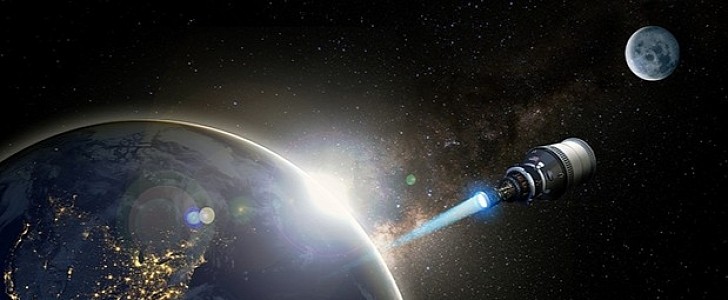Jeff Bezos’ Blue Origin is set to design a nuclear spacecraft, together with Lockheed Martin and General Atomics, after winning a contract with Pentagon’s Defense Advanced Research Projects Agency. The goal is to design and build a demonstration rocket based on a nuclear thermal propulsion system (NTP), by 2025.
With a long history in military research and development, dating back to 1957 when Sputnik’s launch challenged the American space strategy, DARPA is now looking for ways to keep the U.S space program ahead of everyone else's. The Demonstration Rocket for Agile Cislunar Operations (DRACO) program announced recently is part of that strategy.
Current spacecraft technology, that is based on either chemical propulsion systems or electrical-powered systems, has its limitations when it comes to maneuvering agility. This is where the NTP propulsion comes in, as an alternative system that could effectively lead to rapid maneuver. In theory, the nuclear propulsion system would combine the best of electrical and chemical systems, in terms of both efficiency and power.
“The NTP technology we seek to develop and demonstrate under the DRACO program aims to be foundational to future operations in space.” – says Maj Nathan Greiner, USAF, program manager for DRACO.
The three contractors will implement the first phase of the DRACO program over the course of 18 months, divided into two Tracks.
For Track A, General Atomics will be in charge of designing the NTP reactor concept. Lockheed Martin and Blue Origin will take over Track B, when the nuclear spacecraft design is set to be completed. The two aerospace manufacturers will participate in designing an Operational System spacecraft concept and a Demonstration System spacecraft concept.
After completing the first phase in the DARCO program, DARPA’s goal is to launch an on-orbit demonstration rocket and test the new system in the space between Earth and the Moon. If successful, the nuclear thermal propulsion system could change what is now possible in terms of space travel speed.
Current spacecraft technology, that is based on either chemical propulsion systems or electrical-powered systems, has its limitations when it comes to maneuvering agility. This is where the NTP propulsion comes in, as an alternative system that could effectively lead to rapid maneuver. In theory, the nuclear propulsion system would combine the best of electrical and chemical systems, in terms of both efficiency and power.
“The NTP technology we seek to develop and demonstrate under the DRACO program aims to be foundational to future operations in space.” – says Maj Nathan Greiner, USAF, program manager for DRACO.
The three contractors will implement the first phase of the DRACO program over the course of 18 months, divided into two Tracks.
For Track A, General Atomics will be in charge of designing the NTP reactor concept. Lockheed Martin and Blue Origin will take over Track B, when the nuclear spacecraft design is set to be completed. The two aerospace manufacturers will participate in designing an Operational System spacecraft concept and a Demonstration System spacecraft concept.
After completing the first phase in the DARCO program, DARPA’s goal is to launch an on-orbit demonstration rocket and test the new system in the space between Earth and the Moon. If successful, the nuclear thermal propulsion system could change what is now possible in terms of space travel speed.

